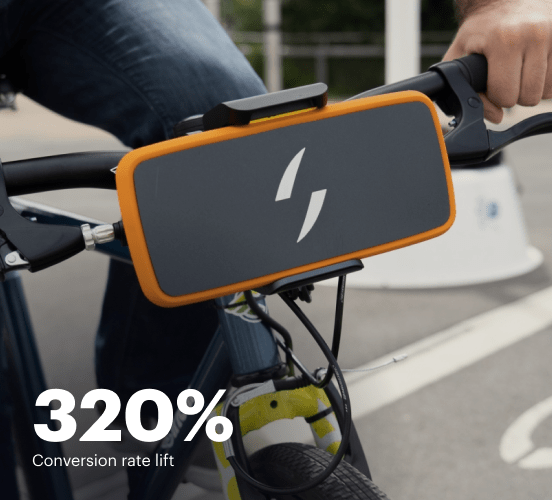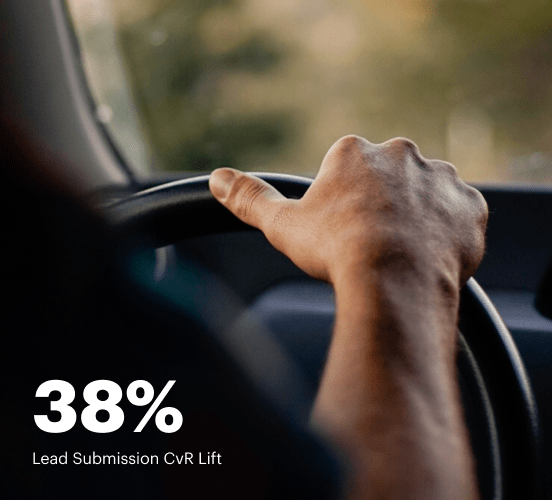How WordPress vs. Adobe Portfolio vs. Instapage stack up against each other
Compare Instapage with WordPress and Adobe Portfolio to create high-converting landing pages. With personalization, optimization, and collaboration tools, Instapage helps you deliver experiences that drive results.
Get startedSee how Instapage stacks up against the competition
| Feature | Instapage | Other builders |
| Drag-and-Drop Tools | ||
| Conversion-optimized templates | ||
| Manual and AI-powered A/B Tests | ||
| AI content suggestions | ||
| Popups and sticky bars | ||
| Canvas and grid blocks | ||
| Reusable and global elements | ||
| Form and popup builders | ||
| Built-in Heatmaps | ||
| Central analytics dashboard | ||
| Ad-to-page personalization and collections | ||
| Contacts, lists, and email | ||
| Dedicated, full-service CRO experts | ||
| Enterprise-ready platform |
Leading the way in building high-performing landing pages





Why Instapage is the smarter choice for your campaigns
Get everything you need to build, scale, and optimize high-converting landing pages—without coding.

Easier page building without coding
Instapage offers a flexible and seamless page creation experience with a library of 500+ conversion-focused layouts, Instablocks®, a drag-and-drop builder, and AI content generation. With technologies like Thor Render Engine®, you can create on-brand, mobile-responsive landing pages that load quickly and start converting during initial visitor clicks.

More insights — better results
Instapage lets you see in detail how each landing page experience and variation is performing so you can make targeted changes that boost page conversions. Use heatmaps for a better understanding of on-page activities, run A/B tests and AI-assisted experiments, and then track and evaluate results within robust analytics dashboards.

More personalized experiences
Instapage lets you quickly create high-performing landing pages tailored to each of your ad campaigns. Deliver personalized experiences for distinct audiences using dynamic text replacement. Effortlessly align specific advertisements to unique pages with AdMaps. Monitor audience-level metrics using our advanced data tools.

Built-in collaboration
Instapage collaboration capabilities bring your entire team together to speed up the process of landing page review, approval, and launch. No more frustrating and unnecessary revisions or edits scattered across emails. Provide instant feedback, conduct real-time page edits, and securely share your pages with outside stakeholders.

Free up time for your business
Invest time into business growth, not busy work. Launch landing pages faster with reusable forms and templates. Build once, reuse forever.
Explore all integrations






Easier page building without coding
Instapage offers a flexible and seamless page creation experience with a library of 500+ conversion-focused layouts, Instablocks®, a drag-and-drop builder, and AI content generation. With technologies like Thor Render Engine®, you can create on-brand, mobile-responsive landing pages that load quickly and start converting during initial visitor clicks.
More insights — better results
Instapage lets you see in detail how each landing page experience and variation is performing so you can make targeted changes that boost page conversions. Use heatmaps for a better understanding of on-page activities, run A/B tests and AI-assisted experiments, and then track and evaluate results within robust analytics dashboards.
More personalized experiences
Instapage lets you quickly create high-performing landing pages tailored to each of your ad campaigns. Deliver personalized experiences for distinct audiences using dynamic text replacement. Effortlessly align specific advertisements to unique pages with AdMaps. Monitor audience-level metrics using our advanced data tools.
Built-in collaboration
Instapage collaboration capabilities bring your entire team together to speed up the process of landing page review, approval, and launch. No more frustrating and unnecessary revisions or edits scattered across emails. Provide instant feedback, conduct real-time page edits, and securely share your pages with outside stakeholders.
Free up time for your business
Invest time into business growth, not busy work. Launch landing pages faster with reusable forms and templates. Build once, reuse forever.
Explore all integrationsGet started with Instapage in a few steps
-
Create your Instapage account
Start with Instapage by signing up via Google or your email. You'll get access to a free 14-day trial to discover Instapage capabilities. Feel free to cancel anytime during the 14-day trial if you decide that our product is not suitable for your business. -
Build and personalize your page
Create your first landing page from scratch or choose a template from 500+ customizable layouts. Use the drag-and-drop builder to add page elements, fonts, and backgrounds, refine content with AI, or add custom HTML, Javascript, and CSS. -
Review and make edits
Collaborate on page designs and streamline review processes. Invite your team members and stakeholders to review, edit, and provide feedback on your landing page. Collaborate knowing your page is confidential and only accessible to authorized users. -
Publish and track page performance
Publish your page to a domain or custom URL. Connect your pages to the ads you've created and track page performance within the analytics dashboard, run A/B tests and AI experiments, analyze results, and continuously optimize your landing page to maintain high conversions.
Instapage vs. WordPress vs. Adobe Portfolio – Finding Your Perfect Match
Choosing the right landing page builder can feel like selecting a VIP lineup for a concert; you want the best performers to elevate your experience. Whether you're a freelance marketer, a small business owner, or a seasoned agency professional, the choice of platform plays a pivotal role in your success. This article pits Instapage, WordPress, and Adobe Portfolio against each other, showcasing their unique strengths and weaknesses, ultimately guiding you to make an informed decision. Prepare yourself for an engaging journey through feature sets, usability, pricing, and more, as we break down these contenders into digestible bits of information.
Introducing the Contestants: A Quick Overview
In our digital arena, we have three formidable players: Instapage, WordPress, and Adobe Portfolio. Instapage is a dedicated landing page platform known for its robust conversion tools, enabling marketers to reduce costs while increasing customer loyalty and conversion rates. On the other hand, WordPress is a versatile content management system that offers extensive customization options and a vast community of plugins, making it a favorite among developers and users alike. Lastly, we have Adobe Portfolio, an elegant platform geared towards creatives, streamlining the process of showcasing portfolios while ensuring that visuals remain the center of attention. With each platform boasting its unique strengths, the rivalry promises to be intriguing.
Round 1: Feature Showdown
Diving into Templates and User Friendliness
When it comes to templates, each platform offers its unique approach to ease of use. WordPress has thousands of themes available, ranging from minimalist to feature-rich options. However, selection can be overwhelming, and some themes may require technical know-how to customize. Adobe Portfolio shines with visually stunning templates tailored for creatives, but it may feel limited for those who need a higher level of customization. This is where Instapage emerges as a champion, presenting beautiful, high-converting landing page templates that are easy to customize, ensuring marketers can quickly create relevant landing page experiences. The intuitive drag-and-drop editor enhances user experience, allowing for seamless integration of multimedia elements without coding knowledge. Overall, while all platforms have quality options, Instapage stands out for marketers looking to maximize their conversion potential.
Instapage: Customization King and Conversion Queen
In the realm of customization and conversion optimization, Instapage pulls ahead of its competitors. With its user-friendly editor, marketers can personalize landing pages down to the smallest detail, ensuring that every element aligns with brand identity and audience expectations. Advanced features like A/B testing, heatmaps, and conversion analytics empower users to make data-driven adjustments, ultimately enhancing performance. Additionally, Instapage's focus on relevant landing page experiences fortifies brand trust among customers, fostering loyalty over time. It's not just about aesthetics; it's about creating a compelling journey for users that converts. From personalized calls to action to optimized layouts, Instapage acts as a trusted partner, dedicated to skyrocketing your conversion rates.
Round 2: Speed and Performance - Who's the Fastest?
Imagine you’re in line at your favorite coffee shop, waiting impatiently for your caffeine fix. Just as slow service can frustrate a customer, delayed webpage loading times can lead to potential leads slipping away. Consequently, speed and performance are essential components of user experience. Each platform has its own strengths and shortcomings in this regard, forming the basis for our second round.
Instapage Superiority:
- Optimized for speed, ensuring quick load times.
- Lightweight and dedicated solely to landing pages.
- Regularly updated to improve performance based on user feedback.
- Highly responsive design that adapts seamlessly to any device.
WordPress Benefits:
- Varies based on hosting; performance can differ significantly.
- Emphasis on caching plugins can enhance loading speed.
- Customization options might impact overall performance if not managed properly.
Adobe Portfolio Pros:
- Designed primarily for high-quality visuals, which can load quickly.
- Integration of creative assets maintains performance on displayed media.
- Simplicity leads to faster page creation without excessive bloat.
In summary, while speed can vary among all three platforms, Instapage clearly leads the pack. Its dedicated framework is geared solely towards creating high-performing landing pages, setting it apart from versatile platforms that often struggle with speed under the weight of added features.
Round 3: User Experience and Learning Curve
Navigating new software can sometimes feel daunting, but it doesn't have to be. This round highlights how user-friendly each platform is for both novices and seasoned pros. Instapage welcomes newcomers with an intuitive experience that does not require a steep learning curve, making it extremely accessible for anyone looking to create effective landing pages. Meanwhile, WordPress offers sophisticated tools, but its steep learning curve can overwhelm some users, especially those without a technical background. Adobe Portfolio, simple and straightforward, caters beautifully to creatives but may not offer enough depth for marketers looking to expand their skills. Ultimately, regardless of your starting point, all platforms support users on their journey toward mastery.
Round 4: Customer Support Teams – Your Allies in the Journey
Every leading platform should be backed by a reliable support squad. Picture customer support representatives as your trusty sidekicks, always available to lend a hand when you're in a bind. Instapage offers responsive support through live chat, email, and extensive documentation, ensuring guidance is never far away. WordPress, while backed by a large community, may offer varied support experiences depending on your hosting provider. Adobe Portfolio features solid customer service, but support is more focused on creatives rather than everyday users. Each platform has its merits, and understanding these differences can be crucial for maintaining smooth operations.
Round 5: Cost Structures – Finding Your Best Value
When it comes to pricing, each platform provides various options that cater to unique needs. Instapage operates on a subscription model that's higher priced than the competition, but its extensive conversion features justify the investment for marketers focused on growth. WordPress is flexible in terms of pricing, but additional expenses can arise from premium plugins and themes, leading to unpredictability in costs. Adobe Portfolio features a subscription included with Adobe's Creative Cloud, making it a smart option for existing subscribers. It blends value and performance, especially for creatives looking to establish an online presence. Understanding these pricing structures allows users to evaluate which platform aligns best with their financial plans and desired outcomes.
To wrap up, while all three platforms have their respective strengths, the best choice ultimately depends on your individual needs and goals. Ask yourself what you prioritize most—features, support availability, or pricing flexibility? Regardless of your selection, consider giving Instapage a try with a free trial or demo to experience its full potential first-hand. A platform designed to empower you in reducing costs, growing conversions, and enhancing customer loyalty awaits!










